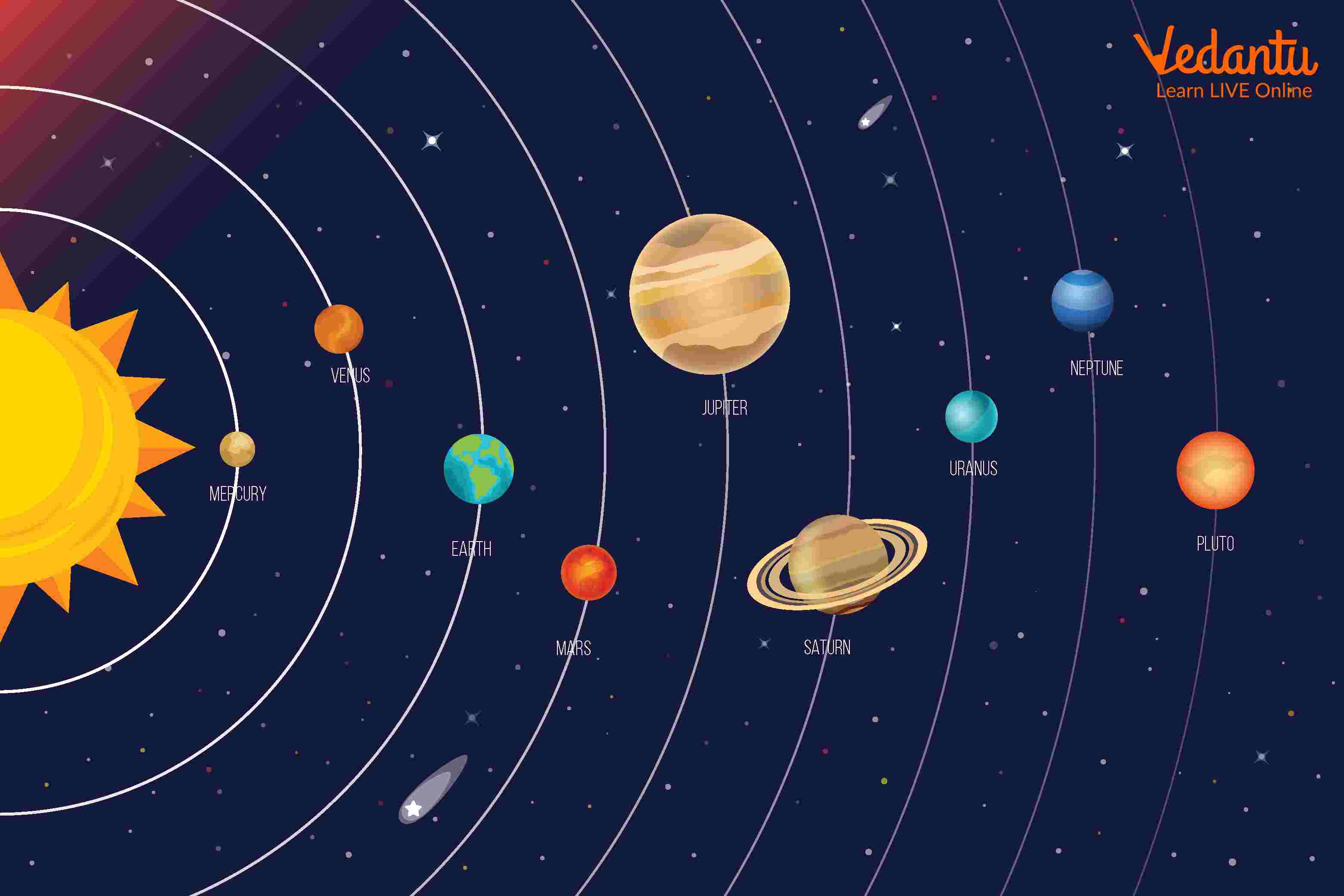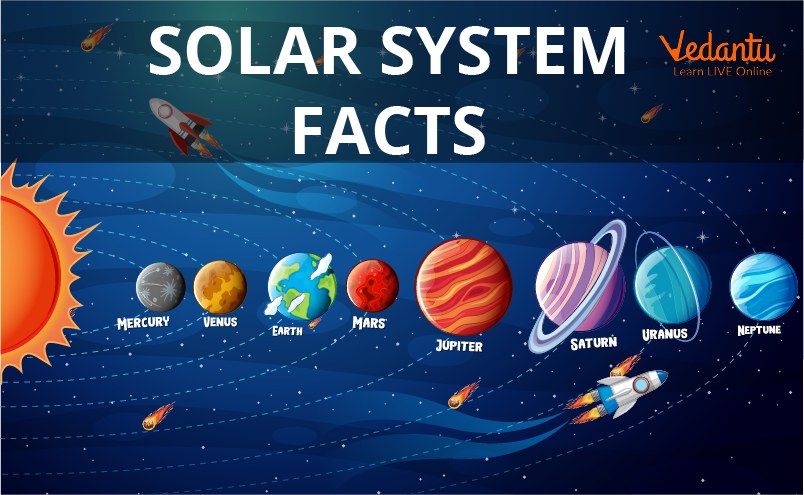




What Makes Our Solar System Unique? Discover Planets, Moons & More
All celestial bodies that revolve or move around the Sun are classified as parts of the solar system. This comprises the eight planets and their moons, as well as dwarf planets, asteroids, comets, and other small, icy objects. Despite this, the vast majority of the solar system is empty space.
The solar system is merely a minor fraction of the Milky Way galaxy, which is a massive structure of stars and other celestial bodies. The solar system orbits the centre of the galaxy once every 225 million years. The Milky Way galaxy is just one of the billions of galaxies that comprise the cosmos. Let’s understand the solar system for kids in an easy and simple language.
What is the Solar System?

Solar System
The Solar System is a space in which there is the Sun and planets revolve around it due to a force known as gravity. The Earth, the other planets, stars, asteroids, and comets that exist in this space make up the Solar System.
Which Type of Star is the Sun?
Our Sun, as you may know, is a star. Even though it is our closest and most recognizable star, it is still just that: a star. Astronomers have been able to see instances of stars in diverse shapes, sizes, metal compositions, and ages since there is a vast Universe out there populated by numerous stars.
The surface temperature of stars in this classification is between 5,300 and 6,000 K, and they produce light by fusing hydrogen into helium. They have a 10-billion-year lifespan on average.
However, there is more to this subject because G V Stars can go through numerous stages. Some are just beginning to form, while others are in their middle years or towards the end of their life, and do you know? The brightest star apart from sun is Sirius.
Importance of Sun
The sun is a common star, one of approximately 100 billion in our Milky Way galaxy. The sun has a huge impact on our planet: it controls the weather, ocean currents, seasons, and climate, as well as allows plant life to exist through photosynthesis. Life on Earth would not exist without the sun's heat and light and i.e. the most significant importance of sun.
The Planets of the Solar System


Solar System
1. Mercury, the Nearest:
Mercury is the planet closest to the Sun. It is made up of rock and is the tiniest planet. It is so close to the Sun that it completes its orbit in 88 days and is much hotter than Earth.
2. Venus, the Hottest:
Venus is the second planet from the Sun after Mercury. It's also composed of stone. Venus, like Earth, has an atmosphere (air) surrounding it, but it is much thicker than Earth's, and Venus is perpetually clouded.
3. Earth, our Home:
This is our home! Earth is composed of rock and is the only planet with liquid water. The other planets are either excessively hot or excessively cold. It takes the Earth 365 days to orbit the Sun.
4. Mars, the Red Planet:
Mars is slightly smaller than Earth, but much farther away. It once had an atmosphere similar to that of Earth and Venus, but it no longer has much of one. Mars is reddish in hue and is sometimes referred to as "The Red Planet.
5. Jupiter, the Largest:
Jupiter is the biggest planet in our Solar System. Jupiter has the capacity to hold 1,321 Earths. It is one of the four "gas giants" and is made of gas. Jupiter has 66 moons, one of which is larger than Mercury.
6. Saturn, Having a Ring:
Saturn is well-known for its rings. Galileo spotted the rings for the first time (with a telescope) in 1610, and they are composed of a large number of little ice and dust particles (mostly ice).
7. Uranus, the Coldest:
Uranus is another of the 'gas giants.' Uranus may hold 63 planets the size of Earth. Uranus orbits the Sun every 84 years and has the coldest average temperature of -220°C.
8. Neptune, the Farthest:
Neptune is the planet that is the furthest away from the Sun. It is 30 times the distance from the Sun as Earth and takes 165 years to orbit the Sun. Neptune is the last of the four 'gas giants,' with a volume 58 times that of Earth.
What is Constellation?
When viewed from Earth, a constellation is a group of visible stars that form a pattern. They may form the shape of an animal, a mythological creature, a man, a woman, or an inanimate object like a microscope, a compass, or a crown in the pattern they create.

Solar System Facts
Facts You Need to Know About Solar System
The Sun is a star that generates light and heat and is composed of heated gas.
Not everything in the Solar System revolves around the Sun. For example, the Moon revolves around the Earth.
The Sun is orbited by eight planets.
The planets in the Solar System are in the following order: Mercury, Venus, Earth, Mars, Jupiter, Saturn, Uranus, and Neptune.
Jupiter is the largest planet, and Mercury is the smallest.
As it rounds the Sun, the Earth rotates. One day equals one full rotation. A year is completed in 365 rotations or days.
Our galaxy is known as the Milky Way, and the Sun is one of the hundreds of billions of stars of the galaxy.
One million Earths might fit inside the sun, which is considered a medium-sized star.
For many years, Earth was thought to be the sole planet in our solar system containing water. NASA recently uncovered the most compelling evidence that there is occasional running water on Mars!
Comets are sand, ice, and carbon dioxide remnants from the formation of our solar system roughly 4.5 billion years ago.
There are no solid surfaces on Jupiter, Saturn, Uranus, or Neptune, so you couldn't walk on them!
Let’s Summarise
You have seen the wonderful facts, planet names of the solar system! Here is the overview of it! The solar system is made up of the Sun and Stars, everything that revolves or moves around it.
The planets of the solar system are:
Mercury
Venus
Earth
Mars
Jupiter
Saturn
Uranus
Neptune
FAQs on Solar System for Kids: Interactive Learning & Exciting Facts
1. What is the solar system in easy words?
The solar system is like a big family in space with the Sun at its center. It includes everything that travels around the Sun, such as the eight planets (like our Earth), moons, asteroids, and comets, all held together by the Sun's gravity.
2. What is at the center of our solar system?
The Sun is at the center of our solar system. The Sun is a giant, glowing star that provides light and warmth to all the planets. Everything in the solar system, including Earth, travels in a fixed path, or orbit, around the Sun.
3. What are the names of the eight planets in our solar system?
The eight planets, in order starting from the one closest to the Sun, are:
- Mercury
- Venus
- Earth
- Mars
- Jupiter
- Saturn
- Uranus
- Neptune
A fun way to remember this order is with the sentence: 'My Very Excellent Mother Just Served Us Noodles'.
4. Why does the Moon seem to follow me when I'm in a moving car?
The Moon looks like it's following you because it is extremely far away. Objects near you, like trees and buildings, pass by quickly as you move. Since the Moon is so distant, it stays in almost the same spot in the sky, making it appear to travel along with you.
5. What is the main difference between a star and a planet?
The biggest difference is that a star, like our Sun, creates its own light and heat. A planet, like Earth, does not produce its own light. We can only see planets because they reflect the light from their nearest star.
6. Why do planets stay in their path and not fly away into space?
Planets stay in their path, called an orbit, because of the Sun's powerful gravity. Gravity is an invisible force that pulls objects toward each other. The Sun's immense gravity constantly pulls on the planets, keeping them from drifting away, much like a ball tied to a string when you swing it around.
7. Why do we have day and night on Earth?
We experience day and night because the Earth is always spinning, an action called rotation. When the part of the Earth where you live is facing the Sun, it is bright and we call it daytime. When that same part spins away from the Sun, it becomes dark, and we call it nighttime.
8. Is Earth the only planet in our solar system with life?
Based on what we currently know, Earth is the only planet where life exists. This is because it has the perfect conditions for life, including liquid water, a protective atmosphere to breathe, and just the right temperature. Scientists are still exploring if life might exist elsewhere.





















